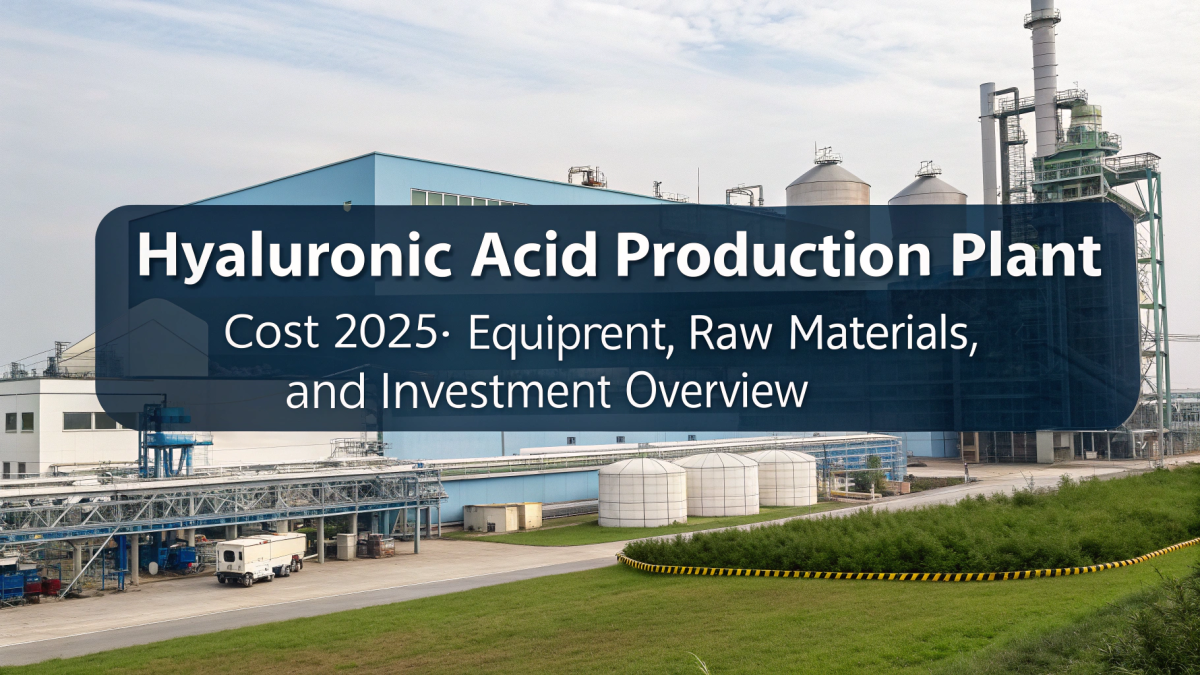
Hyaluronic Acid Production Plant Cost 2025: Equipment, Raw Materials, And Investment Overview
Hyaluronic acid is a naturally occurring polysaccharide found in the human body, especially in connective tissues, skin, and eyes, where it helps retain moisture, lubricate joints, and support tissue repair. Due to its exceptional water-binding capacity and biocompatibility, it is widely used in cosmetics, dermatology, ophthalmology, and pharmaceuticals for applications like skin hydration, anti-aging treatments, eye drops, and joint injections.
Setting up a hyaluronic acid production plant requires investment in fermentation-based biotechnology, purification systems, quality control labs, and sterile packaging units. Key factors include securing microbial strains, GMP compliance, raw material sourcing, and regulatory approvals to meet medical and cosmetic industry standards.
IMARC Group's report, titled “Hyaluronic Acid Production Cost Analysis 2025: Industry Trends, Plant Setup, Machinery, Raw Materials, Investment Opportunities, Cost and Revenue,” provides a complete roadmap for setting up a hyaluronic acid production plant. It covers a comprehensive market overview to micro-level information such as unit operations involved, raw material requirements, utility requirements, infrastructure requirements, machinery and technology requirements, manpower requirements, packaging requirements, transportation requirements, etc.
Request for a Sample Report: https://www.imarcgroup.com/hyaluronic-acid-manufacturing-plant-project-report/requestsample
Hyaluronic Acid Industry Outlook 2025
The hyaluronic acid industry is gaining momentum in 2025 due to its rising demand in cosmetics, pharmaceuticals, and medical applications. Known for its hydrating and anti-aging properties, it is widely used in skincare, dermal fillers, and joint health supplements. Increasing consumer focus on beauty, wellness, and minimally invasive treatments is driving market growth. Additionally, advancements in biotechnology and sustainable production methods are making hyaluronic acid more accessible and cost-effective. With expanding applications and strong demand across healthcare and personal care, the industry outlook for 2025 remains highly promising.
Key Insights for Hyaluronic Acid Production Plant Setup
Detailed Process Flow
-
Product Overview
Unit Operations Involved
Mass Balance and Raw Material Requirements
Quality Assurance Criteria
Technical Tests
Project Details, Requirements, and Costs Involved:
-
Land, Location and Site Development
Plant Layout
Machinery Requirements and Costs
Raw Material Requirements and Costs
Packaging Requirements and Costs
Transportation Requirements and Costs
Utility Requirements and Costs
Human Resource Requirements and Costs
Speak to an Analyst for Customized Report: https://www.imarcgroup.com/request?type=report&id=10945&flag=C
Capital Expenditure (CapEx) and Operational Expenditure (OpEx) Analysis:
Project Economics:
-
Capital Investments
Operating Costs
Expenditure Projections
Revenue Projections
Taxation and Depreciation
Profit Projections
Financial Analysis
Profitability Analysis:
-
Total Income
Total Expenditure
Gross Profit
Gross Margin
Net Profit
Net Margin
Buy Now: https://www.imarcgroup.com/checkout?id=10945&method=1911
Key Cost Components of Setting Up a Hyaluronic Acid Plant
-
Raw Materials : Cost of hyaluronic acid precursors and other chemicals.
Equipment : Investment in reactors, filtration systems, and drying equipment.
Labor : Salaries for skilled workers and technicians.
Facility : Expenses for land, construction, and utilities.
Regulatory Compliance : Costs for permits, inspections, and quality assurance.
Research and Development : Investment in product development and testing.
Marketing and Distribution : Budget for branding, packaging, and logistics.
Economic Trends Influencing Hyaluronic Acid Plant Setup Costs 2025
-
Raw Material Prices : Fluctuations in the cost of bio-based feedstocks impact overall expenses.
Technological Advancements : Innovations in production processes can reduce costs but require initial investment.
Labor Market Dynamics : Rising wages and labor shortages influence operational costs.
Regulatory Changes : Stricter environmental and safety regulations may increase compliance costs.
Global Supply Chain Disruptions : Geopolitical tensions and trade policies affect the availability and cost of materials.
Market Demand : Growing applications in cosmetics and pharmaceuticals drive investment but may increase initial setup costs.
Sustainability Initiatives : Increased focus on eco-friendly practices can lead to higher upfront costs but potential long-term savings.
Currency Fluctuations : Exchange rate volatility impacts imported equipment and materials pricing.
Challenges and Considerations for Investors
-
Regulatory Scrutiny: The industry is subject to strict regulations, especially for medical-grade products like dermal fillers, which can slow down product approvals and market entry.
High Production Costs: Manufacturing pure, high-quality hyaluronic acid, particularly for injectable applications, is expensive, impacting profitability and product pricing.
Competition and Alternatives: The market is competitive, with many players and the existence of alternative ingredients like ceramides and squalene, which can limit market growth.
Supply Chain Volatility: The market can be affected by supply shortages and fluctuating raw material costs, creating potential disruptions for manufacturers.
Conclusion
This report aims to serve as a practical guide for entrepreneurs, investors, and industrial planners exploring opportunities in hyaluronic acid production. By understanding the cost structure, market dynamics, and operational challenges, stakeholders can make informed decisions and devise sustainable strategies for entry and expansion in the sector.
About Us: IMARC Group is a global management consulting firm that helps the world's most ambitious changemakers to create a lasting impact. The company excel in understanding its client's business priorities and delivering tailored solutions that drive meaningful outcomes. We provide a comprehensive suite of market entry and expansion services. Our offerings include thorough market assessment, feasibility studies, company incorporation assistance, factory setup support, regulatory approvals and licensing navigation, branding, marketing and sales strategies, competitive landscape, and benchmarking analyses, pricing and cost research, and procurement research.
Contact Us:
IMARC Group
134 N 4th St., Brooklyn, NY 11249, USA
Email: sales[@]imarcgroup.com
Tel No:(D) +91 120 433 0800
United States: (+1-201971-6302)
Legal Disclaimer:
MENAFN provides the
information “as is” without warranty of any kind. We do not accept
any responsibility or liability for the accuracy, content, images,
videos, licenses, completeness, legality, or reliability of the information
contained in this article. If you have any complaints or copyright
issues related to this article, kindly contact the provider above.


















Comments
No comment